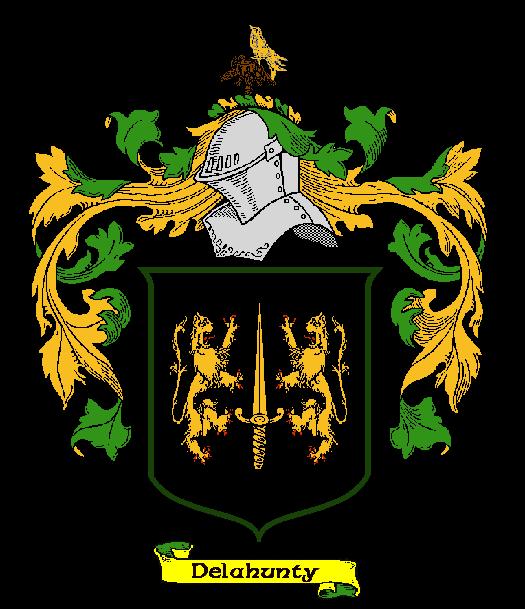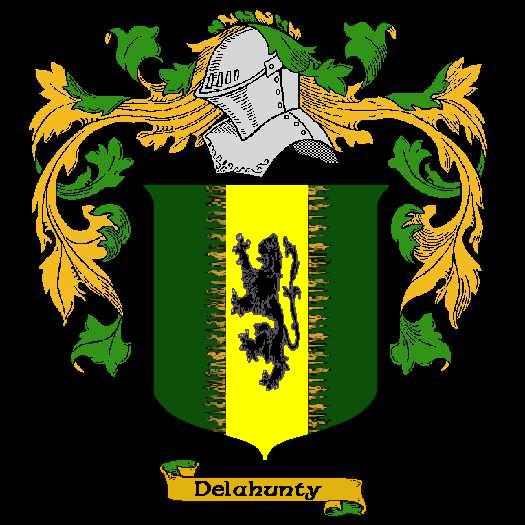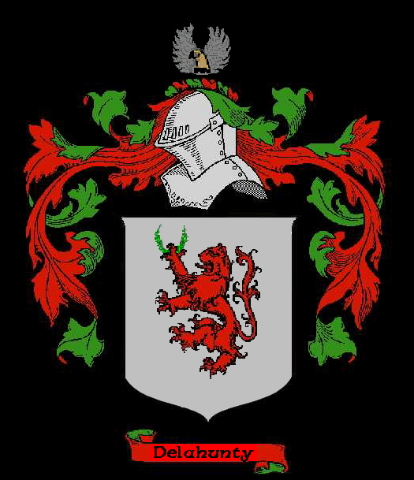The original purpose of the coat of arms was to distinguish one combatant from another when clad in armour. In addition to being displayed on shields, armorial designs were frequently enamelled on the breastplate and embroidered on the medieval surcoat or great-coat and this is where the expression 'coat of arms' comes from. The term 'arms' being an abbreviation for 'armorial bearings'.
Shields were designed to be easily described in Norman French, the original language of Heraldry, (although some scholars maintain that the Irish had a heraldic system before the Normans arrived) to be duly noted in the record rolls of the heralds. The technical term for such a verbal description is 'blazon' from the Latin blasana meaning shield.
As many of you who have been searching for information on the history of the Delahunty sept may have realised by now, it's not that easy to find. One particularily difficult task is to unearth any information on our family coat of arms and crest.
During my research I came accross no less than three different coats of arms being passed off as that of the Delahuntys. I have presented these here.
The first is the one referred to by the vast majority of heraldic artists around Ireland. I've seen it in numerous pubs, shops and books where it's claimed to be the Delahunty arms. One thing to note is that it's remarkably similar to that of the O' Carrolls of Ely, perhaps reflecting the closeness between the two septs.
 I have, however, recently been in contact with Mr. Fergus Gillespie, Deputy Chief Herald of Ireland, who tells me that there is no regestered arms for any Delahunty (or any of it's variations) save for that granted to Richard Venour Beckwith Dulhunty of Australia in 1950. The correspondance can be viewed here, but I suggest that the reader read the rest of this page first, as it will put the correspondance in context.
I have, however, recently been in contact with Mr. Fergus Gillespie, Deputy Chief Herald of Ireland, who tells me that there is no regestered arms for any Delahunty (or any of it's variations) save for that granted to Richard Venour Beckwith Dulhunty of Australia in 1950. The correspondance can be viewed here, but I suggest that the reader read the rest of this page first, as it will put the correspondance in context.

 The Dulhunty coat of arms granted to Richard Venour Beckwith Dulhunty of Australia in 1950 can be viewed here. Many thanks to Kerri Dulhunty for mailing me these photos, and for kindly allowing me to reproduce them here. Although it is strictly Richard Venour Beckwith Dulhunty's coat of arms and not a family coat of arms, it's probably the nearest thing we Delahuntys have to having our own coat of arms! You'll note that the arms, whilst looking similar to the O Carroll arms displayed here, it is coloured differently. However, it is almost identical to some of the private O Carroll arms. You can view these arms here if you click on the "Armory List" on the side menu. Many thanks again Kerri!
The Dulhunty coat of arms granted to Richard Venour Beckwith Dulhunty of Australia in 1950 can be viewed here. Many thanks to Kerri Dulhunty for mailing me these photos, and for kindly allowing me to reproduce them here. Although it is strictly Richard Venour Beckwith Dulhunty's coat of arms and not a family coat of arms, it's probably the nearest thing we Delahuntys have to having our own coat of arms! You'll note that the arms, whilst looking similar to the O Carroll arms displayed here, it is coloured differently. However, it is almost identical to some of the private O Carroll arms. You can view these arms here if you click on the "Armory List" on the side menu. Many thanks again Kerri!

NOTE: The Dulhunty branch of the family in Australia use the motto: "Take a good Gripe". Another point worth noting is that the Irish College of Arms confirmed the above arms to the Dulhunty family in 1950. (Sources: Mr. Fergus Gillespie, Deputy Chief Herald; Dulanty Ancestry, Larry Jones, 1976; The Dulhunty Papers, Beryl M. Dulhunty, 1959.)

The folllowing two family arms are quoted on various web sites as being the Delahunty arms. However, I think these claims are false.
The first of the two arms is very similar to the arms of the O' Haras. The O' Haras are also members of the Ciannacht, as they descend from Cormac Galeng, the father of Lughaidh from whom the Delahuntys descend. So maybe the confusion stems from here?
However, the websites www.traceit.com and www.swyrich.com, upon which I found the last coat of arms on this page (please note that from April, 2003, swyrich.com have been displaying the O Carroll coat of arms as that of the Delahuntys, and also claim that the Delahuntys originated in Ormond and not in Mayo), state that the Delahuntys descend from Lughaidh, son of Cormac Galeng (which is true), and possessed lands in Mayo/Sligo (this is the part that makes me sceptical, as I will explain...).
Since no Delahuntys are present in that part of Ireland, and there is no proof in any census that they have (in fact in the census of 1659, Delahuntys are to be found quiet commonly in the Baronys of Ballybrit in Offaly and Crannach in Kilkenny, which would seem to indicate that they never moved too far from Eile) we are inclined to doubt their accuracy.
But, Headhra, or O'Hara was chief of Lughne (derivation of Lughaigh?), now the baronyof Lieney, Sligo. It previously included parts of Costello and Gallen, which got it's name from the territory of Galenga , in Mayo. The Galenga territory comprised the entire of the Diocese of Ardagh and included the patrimonies of the families of O'Hara and O'Gara, whose tribe name was Gallenga. Galenga was called in 1537, "MacJordan's Country" and derived from Cormac Gaileang who was given the lands by King Cormac MacArt, in the 3rd century. Apart from an area in Mayo/Sligo being called after Cormac Galeng, the appearance of the placename "Lughne" suggests a possible link to Lughaidh. But is this where the Delahuntys originated, as is claimed on the two websites mentioned above?
I researching this, I looked up all of the information I could find on these baronys, and tried to find any other baronys which had a link to the Delahunty name. I found the following information from the website http://pw1.netcom.com/~walshdw/connacht.htm#lui
Luigne and Gailenga - Counties Sligo and Mayo. The chiefs of Luigne (barony of Leyney in Co. Sligo) and Gailenga (barony of Gallen in Co. Mayo) included O'Hara (Ó hEaghra) and O'Gara (Ó Gadhra), who often alternated as lords. The Luigne-Galenga territory comprised the Diocese of Achonry. By the 12th century the O'Garas were lords of the territory of south Luighne, anciently referred to as Gailenga, which was referred to at that time as Sliabh Lugha. The O'Hara's retained the name Luighne for their territory to the north. The O'Garas were expelled into Cuil-Ui-Fionn (barony of Coolavin, Co. Sligo) by the MacSurtains (the Anglo-Norman Jordan family), and became lords of Coolavin, under the MacDermot clan. For a map of the area click here.
As you can see, there's no mention of the Delahunty sept.
On this site http://offaly.local.ie/content/28150.shtml/genealogy/surname_origins.html we are told:
Minor septs with Offaly origins include: Bannon, Beary (now called Berry), Bracken, Brohan, Bunhilly (now called Buckley), Clavin (sometimes anglicised as Swords), Condron, Conley, Conrahy (now called Conroy), (Mac)Corcoran, Crossan, Cunneen (now Rabbitt), Coulahan, Delahunty, Dooley, Flattery, Heaven, Heenan, Heerin, Hennessy, Killacky, Kinnarney, Malone, Maher, Melody/Mulleady, Mooney, Morahan/Morrin, Pillon/Poland, Rigney.
And finally, on this site https://www.angelfire.com/my/tray/Page-2.htm we find:
III.- The Clan Cian were, as already stated, located in Ormond or the present county of Tipperary; and the heads of the Clan were O'Carroll, princes of Ely. The other families were-- MacKeogh (or Kehoe), O'Corcoran, O'Dulhunty (anglicised O'Delahunty), O'Meagher, O'Connor, chiefs of Cianaght (now Keenaghtt) in the county Londonderry; and O'Gara and O'Hara, lords of Lieny and Coolavin in the county Sligo, were also branches of the Clan Cian of Munster.
Both of Larrys sources are from Beryl Dulhunty's "The Dulhunty Papers", published in Sydney Australia in 1959.
The first piece of evidence is that Beryl's (or her husband's) ancestor was Dr John Dulhunty, who was a ship's surgeon on a convict ship who immigrated from England to Australia in 1826. He brought with him a coat of arms, used by the family on their household silver, their personal effects, and their writing paper - the O'Carroll coat of arms. It seems very unlikely in an age when a lawsuit might have ensued from misappropriation of a coat of arms, that one would fake that.
The second piece of evidence, as the Dulhunty Papers also report, is that there was a person in county Kerry who was using both Delahunty and Carroll as last names as late as 1735: "Here lyeth ye body of Phillip Carrel als [meaning aka] Delahunty Mr, who departed this life in ye 22nd yeare of his age ye 11th of January 1735," citing Betham's Wills and Pedigrees, the Genealogical Office, Dublin.
Although it might seem strange to us nowadays, it's impossible to discount the idea of using two names. Using different last names occurs among the Welsh and Scots also. An example was given to me by Larry Jones (who is of Welsh descent) where he has one ancestral family in which brothers who immigrated to the US split three ways in terms of which ancestral name to adopt as a last or family name, when they were forced to adopt the English system of names.
From the evidence above, I think we can say that there is no evidence for either of the arms below being Delahunty arms. In fact, we can be pretty sure that the first one is actually the O' Hara arms which has been confused somewhere along the line with the Delahunty arms. This is understandable when you consider that the founder of the O' Haras (Cormac Galeng) was the father of Lughaidh (founder of the Delahuntys).
The second one I've only seen under the name Delahunty. There are, however, some curious "co-incidences"! For example, the lion holding the laurel wreath is very similar to the O'Hara and O'Gara crests which display a demi-lion holding a laurel wreath, & the O'Hara crest for the Buhide branch is a hawks head between 2 wings. Also, the motto "Try", is one of the 2 mottos sometimes given for O'Hara (the other one being "Virtute Et Claritate").
It could be possible that the Delahuntys in Sligo used the Arms of O'Hara Buhide, & those in Eile that of O'Carroll. However, the mantel colors displayed are unusual. It's possible that Crannach was part of what was later to become Upper Ossory under Gilpadric MacCarroll branch, a son of king Carroll of Eile and Ossory. That might be from where the red lion comes. Also, as I've stated before, there's no evidence of any Delahuntys ever having been in the Mayo/Sligo area, which weakens the case for these arms being that of a Delahunty.
After researching, I've come to the conclusion that although the Delahuntys don't seem to have a unique arms, the arms at the top of the page is probably the closest we have to arms of our own. The arms are the same as the O' Carroll arms. I've been in contact with some Clan Cian researchers/historians who tell me that the Delahuntys were ruled by a lesser chieftan, but one who was nonetheless important enough to share the arms, probably because of early intermarriage.
Here are the two othe coats of arms I have found under the Delahunty name.


The coat of arms below is referred to on the sites www.traceit.com and www.swyrich.com. On the latter of the two sites, it is claimed "Spelling variations include: Delahunt, Delahunty, DeLahunte, DeLaHunty, De-la-Hunt and many more. First found in in counties Mayo and Offaly where they were seated as Chiefs in the barony of Gallen in county Mayo. Lughaidh, the first chieftain, and progenitor of the clan was the grandson of Teige, son of Cormac Galeng who gave his name to the original barony in Mayo. Some of the first settlers of this name or some of its variants were: Mr. DeLaHunt who settled in San Francisco Cal. in 1850; Richard Delahunt settled in Philadelphia Pa. in 1811; John DeLahunte settled in Philadelphia in 1865; John Delahunty settled in Philadelphia in 1868; Thomas Del and others".

 Home Page
Home Page